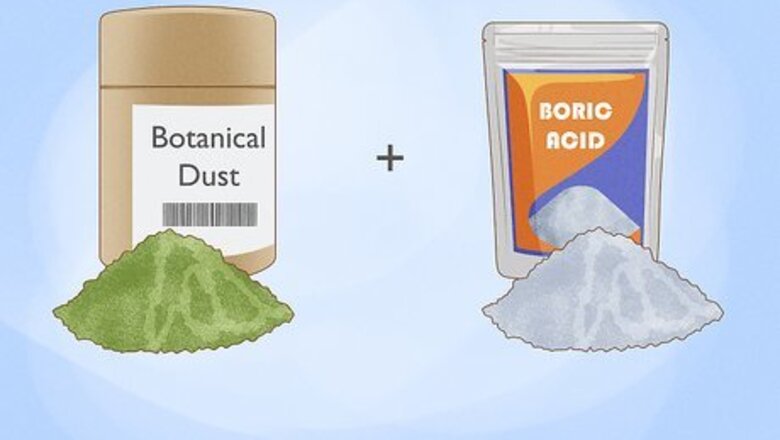
views
Treating Your Home with Insecticide

Mix botanical dust with a borate powder or boric acid. The easiest way to kill fleas is when they are at their most vulnerable: in the egg and larval stages of their development. This mixture will help prevent a full bloom of fleas. Borates are minerals that are used widely as wood preservatives, detergents, and insecticides, acting as stomach poisons to fleas. An adult flea will live on average 2 to 3 months and as long as 100 days without blood from its host. Newly hatched larvae, on the other hand, must feed within 3 days or they’ll starve. So it's easiest by far to attack the larvae first.
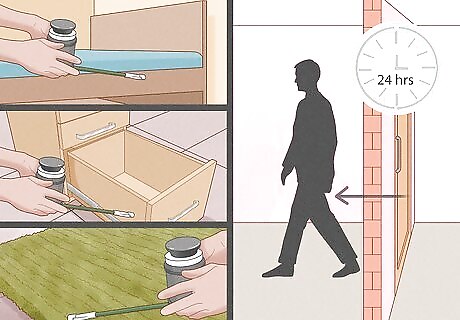
Dust the carpet, the furniture, and the bed with the borate mix. If you have pets, you can also dust the dog or cat's bed. It's best to do this when you're leaving your house for a good while, say 24 hours. Arrange for your pets to be out of the house during this time, too. Let the mixture settle for a day. When you come back, vacuum the carpet, the furniture, and wash the sheets on both beds. Take care not to breathe in the botanical dust and borate mixture. Use a mask when applying the dust mixture in the home. Use the insecticide in well-ventilated areas and wear gloves. Repeated exposure to insecticides can be harmful to pet and human health. Because of the long flea life cycle, 2 or 3 insecticide treatments, spaced 3 weeks apart, are often needed to completely rid your home of a flea infestation.

Set several flea traps out in your home along with the borate mix. Flea traps work by producing light over the trap, which itself contains a flea-killing insecticide. Setting out traps will ensure that you kill any fleas that aren’t killed by the borate mix. Fleas are attracted to the heat and the brightness of the light, and fall into the trap, where they are killed by the poison. If you have inquisitive pets who might try to open and eat the contents of the flea trap, set the in a place they cannot access. Or, place the flea traps in rooms that you can keep your pets out of.
Killing off Fleas without Insecticides
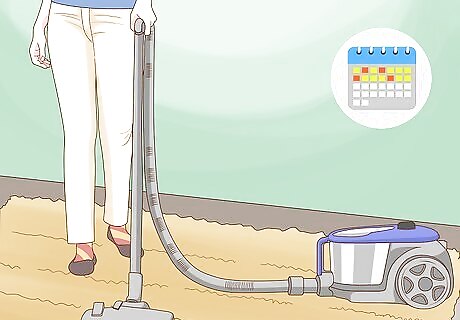
Vacuum your house twice daily for 2 weeks. Vacuum over any flea-affected areas, including high-traffic areas where the pets usually roam. Be sure to move furniture and vacuum underneath it, and also vacuum rugs and out-of-the-way sections of carpet. Then, vacuum off any upholstered furniture as well. Most fleas will not be able to survive a good vacuum! People often go for high-powered, super-suction vacuums, but the average vacuum should do the trick perfectly. Always discard the vacuum bag after you vacuum. This will help discourage re-infestation.
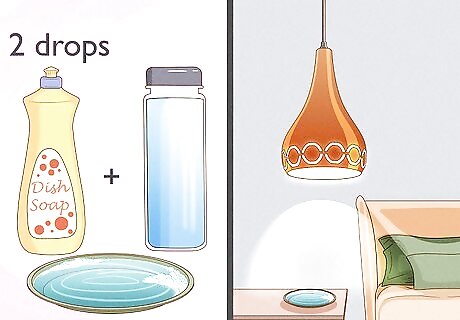
Fill shallow bowls with water and 2 drops of dish detergent. Pour the water and detergent mixture in a very shallow bowl, low enough to the ground so that the fleas could accidentally hop into it. Then, place the mixture next to a low-hanging light source, preferably a night-light. The fleas are attracted to the light. Approaching the light, many of them will fall into the mixture and die in the process. The water and dish detergent mixture is like a toxic swimming pool for fleas. When they jump into the mixture, they die. If you don’t have a shallow bowl, an old Frisbee does the job quite well.
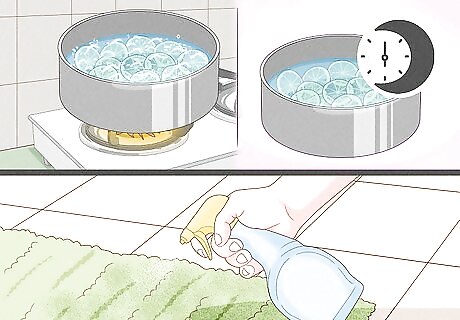
Spray a lemon solution in affected areas. Thinly slice one whole lemon and drop it into a pint of water. Bring the water to a boil. Then, let the solution stand overnight for maximum potency. Pour into a spray bottle and spray onto affected areas. A slice of a different citrus fruit—e.g., orange, lime, or grapefruit—should work as well.
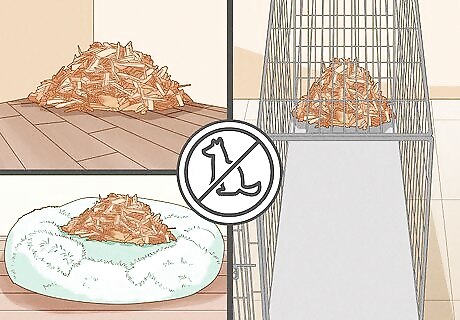
Set out cedar chips in flea-ridden areas. Place cedar chips in the corners of rooms, in the dog pen or bed, and under furniture. You can also place cedar chips in a cotton cloth between the cushions on your furniture, underneath your pillow and, if possible, in your bedding. This will ensure that your bed remains pest-free. Fleas hate the smell of cedar and will do almost anything to avoid it. Cedar chips are available in your local pet or home-supply store. Make sure your pet isn't allergic to cedar. Many dogs can be allergic to cedar. If your dog has an allergic reaction to the cedar—e.g., sneezing or swollen eyes—stop using the cedar chips.
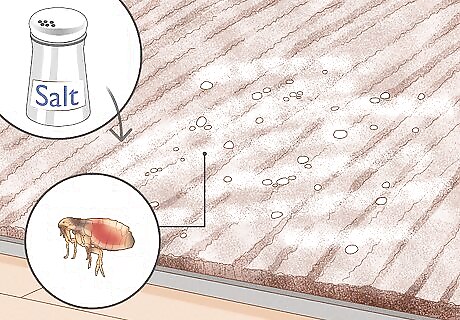
Spread salt over the surface of your carpet. Salt is a desiccant, meaning it saps the moisture from things and dries them out. When a salt crystal attaches itself to a flea, it will cause chafing and scraping on the flea, essentially bleeding the flea to death as it walks. After 7–10 days, vacuum the salted area very thoroughly, making sure to pick up all the salt and flea carcasses from the carpet area. Repeat the salting process 1 or 2 more times. Use very fine-grained salt for this. The finer the better; you want it to be small enough to attach to the flea. When you're done vacuuming, discard the old vacuum bag and replace it with a new one.
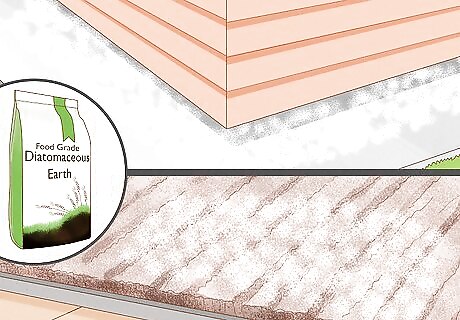
Sprinkle food-grade diatomaceous earth around your house. Much like salt, diatomaceous earth will kill fleas by chafing their bodies. Sprinkle a few spoonfuls over areas of carpet that are infested with fleas. You can also use diatomaceous earth preventatively by sprinkling some around the entrances to your home. Purchase diatomaceous earth at a feed store, a hardware store, or a home-supply store. You can put diatomaceous earth on your pets, as long as you keep it out of their eyes and ears. Sprinkle on your pet down the backbone and rub into the skin all over.

Spray floors and bedding with an Insect Growth Regulator (IGR). IGRs are a type of chemical insecticide which stop the fleas from developing. The larvae simply die off, rather than becoming adult fleas which will reproduce and make more fleas to infest your home. The IGR thereby breaks the reproduction cycle. This allows you to bring large infestations under control. Typically, the mixed IGR will need to be applied 2 times, each about 3 weeks apart. The most economical method is to buy a concentrate and mix according to the directions that come with the product. You can purchase IGRs at a local hardware store. IGRs are not poisonous to mammals. This makes IGRs a good option around a house that has kids or small animals such as hamsters, reptiles, or fish. EXPERT TIP Scott McCombe Scott McCombe Pest Control Specialist Scott McCombe is the CEO of Summit Environmental Solutions (SES), a family-owned local pest solutions, animal control, and home insulation company based in Northern Virginia. Founded in 1991, SES has an A+ rating with the Better Business Bureau and has been awarded “Top Rated Professional,” and “Elite Service Award" by HomeAdvisor. Scott McCombe Scott McCombe Pest Control Specialist Our Expert Agrees: In some cases, you can apply a pesticide to your floors to help stop an infestation before it gets out of control. Look for a product labeled for indoor flea control containing a residual adulticide with a growth regulator (IGR
Treating Your Pet for Fleas
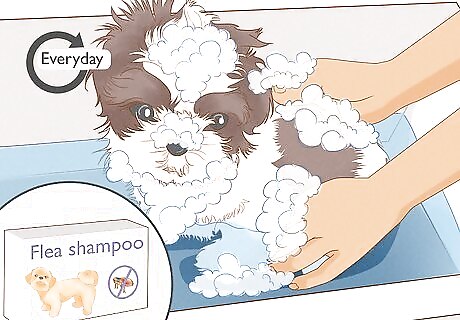
Wash your pet every day with flea soap and water. Washing your pet will kill the fleas that may be living on it. Prepare your pet for the bath by applying the flea soap near the pet’s ears, eyes, nose, mouth, and butt. When fleas feel water, they immediately look for safe places on the pet to hide out, such as around the neck, on the head, and near the anus. Do this before you get the pet wet. There may be a host of other fleas in various stages of their life cycle waiting to hop onto your pet, so be sure to use this method with other preventative measures, such as vacuuming, borate mixes, and cedar chips.
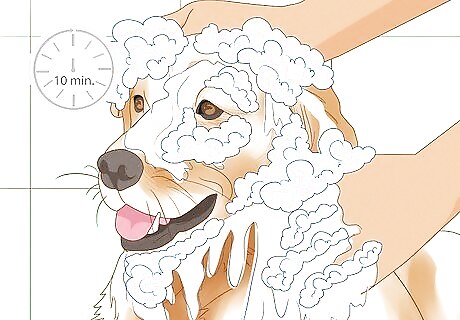
Work in the soap and let the solution stand for at least 10 minutes. After you've applied the soap to the pet’s vulnerable areas, get the pet wet and lather its whole body up. Once the 10 minutes have passed, wash all of the soap out of the pet’s fur with warm water. Then, once the pet is dry, comb out the dead fleas. Take a shower immediately after washing your pet because some flea shampoos can cause irritation when left on human skin for prolonged periods of time.
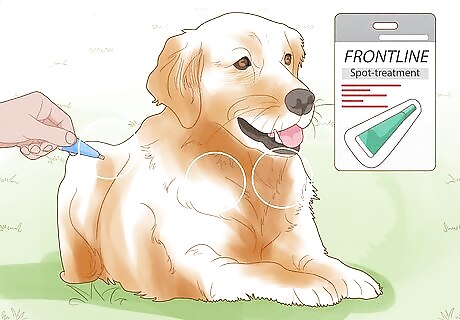
Use a flea product on your cat or dog. Flea products, such as Advantage or Frontline, are spot-treatments that are applied to pets monthly. Usually, these spot-treatments are dropped directly onto the skin of your pet, usually between the shoulder blades and at several spots down the spine. The treatment will then work its way through the skin (integumentary system). You can purchase pet-friendly flea products at your local pet store. You can use flea products in conjunction with a fine-toothed flea comb. Use a flea comb to pull off individual fleas from the pet's fur. EXPERT TIP Scott McCombe Scott McCombe Pest Control Specialist Scott McCombe is the CEO of Summit Environmental Solutions (SES), a family-owned local pest solutions, animal control, and home insulation company based in Northern Virginia. Founded in 1991, SES has an A+ rating with the Better Business Bureau and has been awarded “Top Rated Professional,” and “Elite Service Award" by HomeAdvisor. Scott McCombe Scott McCombe Pest Control Specialist Our Expert Agrees: To prevent fleas from coming back, treat your pets for fleas regularly by using dips or systemic oral or dermal flea control products that are labeled for use on domestic pets.
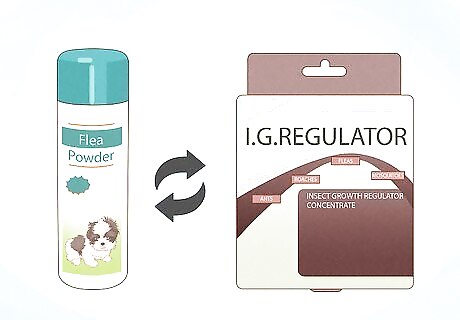
Rotate types of treatments if the first is ineffective. This will prevent flea adaption to the treatments. You may find that some of the standard flea treatments are ineffective because the local flea population has adapted to a particular treatment (including the chemicals in flea collars). In this case, switch among other treatments and use an insect growth regulator (IGR) such as Nylar. For example, if a flea collar isn’t working, try scrubbing your pet with flea powder. Your veterinarian will sell oral tablets that you can give your pet. These tablets attack the flea’s nervous system via the bloodstream and tissue of your dog or cat. While they kill all the fleas feeding on your pet, they do not prevent fleas. The use of an IGR will not allow propagation of succeeding generations and will prevent, in large measure, fleas adapting to the treatments.
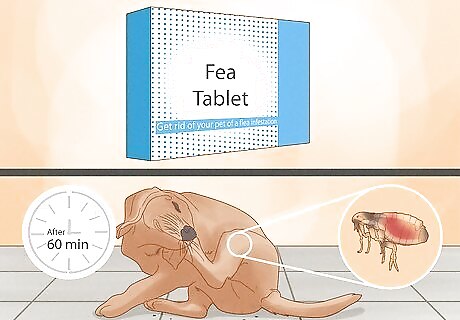
Administer a flea tablet orally to rid your pet of a flea infestation quickly. Flea tablets are given orally and take effect within several hours. Flea tablets kill off all of the fleas on an animal within about 60 minutes. However, the tablets are not preventative and will not make your pet immune to becoming infested with fleas a second time. Once the tablet has killed off the fleas, wash the animal to rid it of the dying fleas if you see the animal scratching. Some cats may become hyperactive, vocalize more, or show panting when given flea tablets. If this happens, try cutting the recommended dose, but you may have to discontinue use of tablets with sensitive cats.
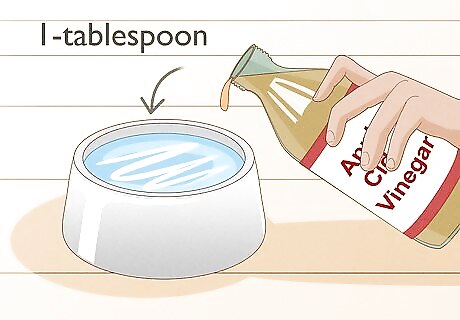
Add deterrents to the pet's meal. Since fleas feed on the blood of animals, you can treat fleas by manipulating what your pet eats. For example, mix vinegar into dogs' water. Mix a tablespoon of apple-cider vinegar into the dog's water bowl, or bathe the animal using water and vinegar. Don't try this with cats, as their pH is much more sensitive than dogs'.











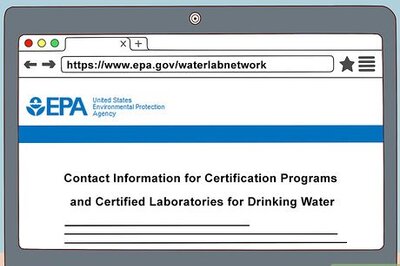








Comments
0 comment